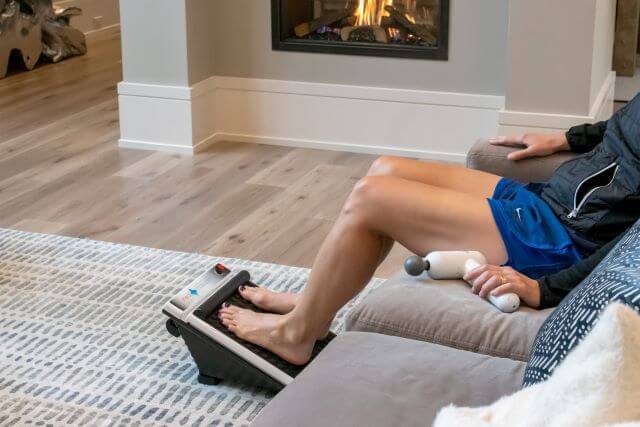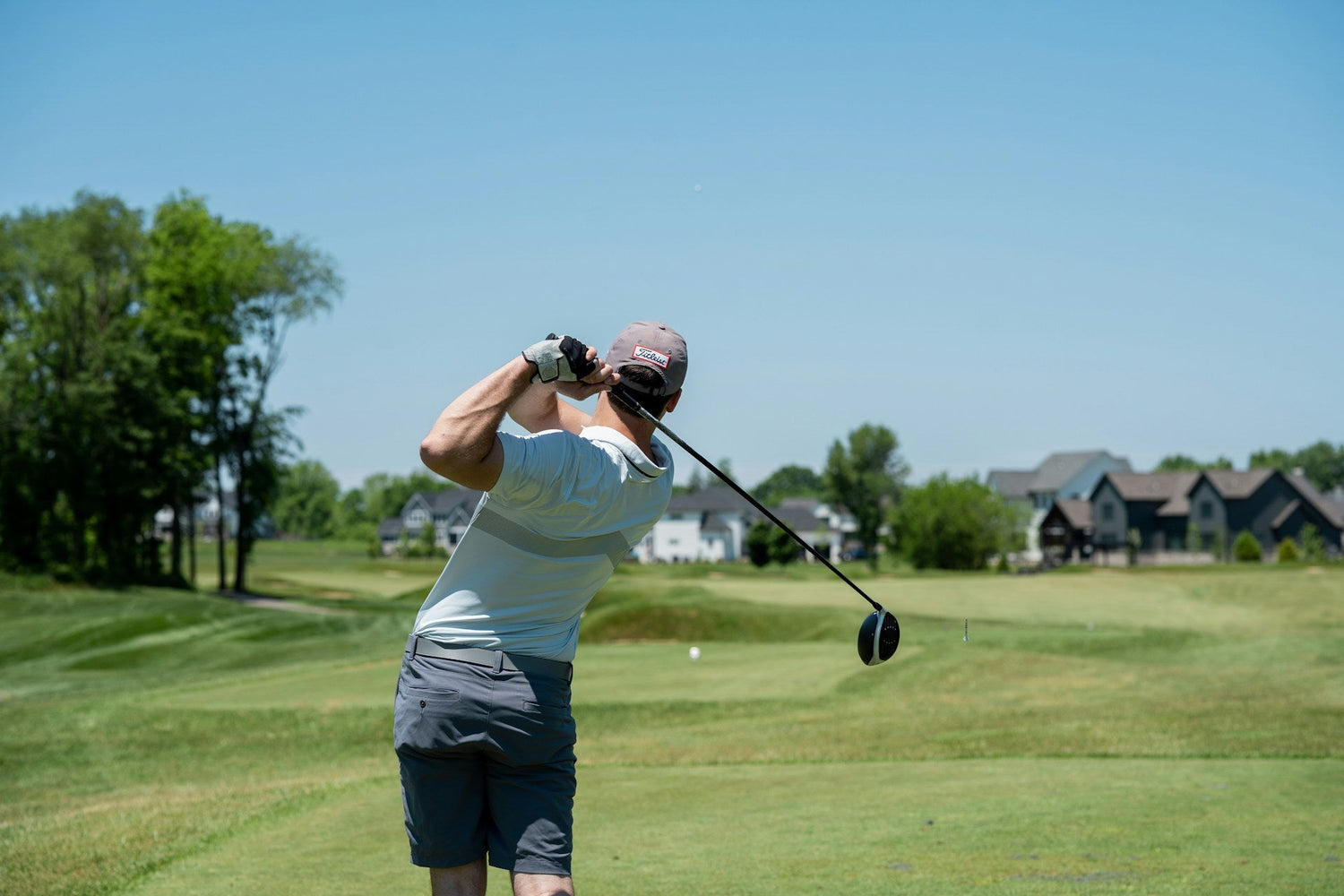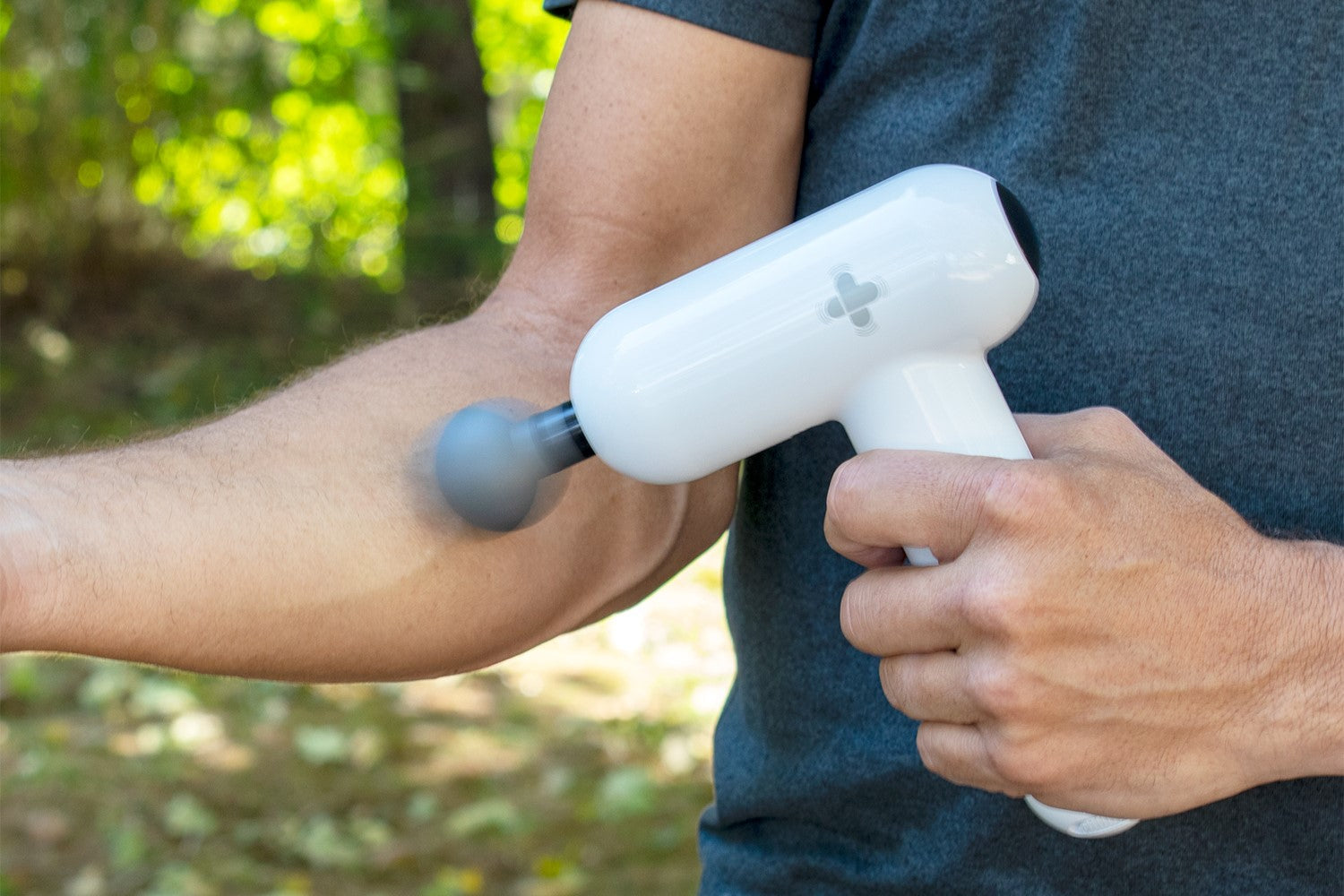As a golfer, there’s nothing like hitting the course after a long week. But if every 18-hole round leaves you with new aches and pains, there’s one tool that could change the game for your recovery routine: Massage therapy.
Whether you’re dealing with golfer’s elbow or just want to move better, massage can support your precision, comfort, and performance on the course. (So much so that many pros have even started carrying massage guns with them while they play!)
How can you try it for yourself? Learn everything you need to know about massage for golfers below, including tips for pain, mobility, and more.
Common Golfer Injuries
Golf might seem like a relaxed sport. But the biomechanics of your swing — along with the distance you might travel while hauling your golf clubs — can take a toll on your body.
After all, you have to generate serious force to send the ball flying hundreds of yards toward the green. It requires power from the rotation of your entire torso — and repeating this motion over four hours can leave your body strained and sore by the end of the round.
Needless to say, golfers often face a wide range of strains and injuries. Some of the most common ones include:
Golfer’s Elbow
Golfer’s elbow (medial epicondylitis) is one of the most well-known injuries in golf. It occurs due to repetitive strain on the tendons near the bony bump on your inner elbow, and can feel like:
- Pain along the forearm
- Stiffness around the joint
- Tingling or numbness
Back Pain
If you’re a golfer, you know that back pain can come in many forms. The repetitive twisting motion of swinging your clubs can put stress on your spine, often leading to lower, middle, and/or upper back pain.
The good news is that golf-induced back pain is usually a simple case of sore muscles. But sometimes, it can also be related to spine or disc issues.
Foot and Heel Pain
Foot, ankle, and heel pain like plantar fasciitis are also not rare among avid golfers. Even if you ride in a cart, your swing itself can also strain the ankles and feet, which could lead to post-round pain.
What Are the Benefits of Massage for Golfers?
From better flexibility to relieving golf-induced soreness, here are six of the most valuable benefits of massage for golfers:
1. Better Range of Motion (ROM) and Flexibility
A quick massage can boost blood flow, stretch stiff muscle tissue, and break up tense fascia. And in turn, it can improve your range of motion while you golf.
In a post from GOLF.com, TPI-certified fitness coach Michael Carroll explains why mobility is so crucial in this sport: Not only does it make your swing more comfortable, but it also helps you generate faster club speeds.
In other words, better ROM helps you swing with all of your power, without being held back by stiff shoulders, hips, or back muscles — and it’s why some golfers keep a massage gun on hand when they hit the course.
2. Soothes Golf-Related Aches and Pains
Muscle pain can put a serious damper on your golf game, whether you’re playing with friends or competing in a tournament.
Luckily, a good massage can melt away shoulder, arm, and back pain due to golf. It works by stimulating the nerve fibers in your soft tissue, helping relax your body and ease sensations of pain.
On top of that, a 2020 review found that sports massage can also help relieve delayed onset muscle soreness (DOMS).
3. Supports Mental Sharpness
Hitting your peak performance in golf is just as much a mental game as it is physical.
But did you know that massage can actually help boost your mental sharpness? By calming your body and stimulating your muscles, it can help you focus and center yourself in the moment. And as a result, it can give you an edge on the course.
A systematic review from 2023 notes that massage can lead to several psychological benefits for athletes, including:
- A reduction in depression, anxiety, and stress levels
- An increase in mood
- A decrease in feelings of fatigue
- A boost in relaxation
- Better perception of recovery
4. Promotes Healthy Posture
Not only can massage boost ROM, but it can also ease stiff muscles that may be pulling your body out of alignment. And this can encourage healthy posture while you golf.
For example, a 2017 study found that a short massage reduced tension in the traps — some of the largest, busiest muscles in the upper back. By relieving tightness in this zone, you could find it more comfortable to stand in a natural, upright posture on the course.
That being said, a proper massage can help with more than just the upper back. It can also ease tension in the hips, glutes, lower back, and neck, helping your body stay better aligned as a whole.
5. Breaks Up Trigger Points
Trigger points (or knots) are hyperirritable, tight bands of tissue that not only cause pain, but can also significantly limit your swing range of motion.
Common hotspots for trigger points include the upper back and shoulders. But they can turn up anywhere — even in your quads, hamstrings, or arms. Thankfully, you can break up knots using a few seconds of moderate, sustained massage.
This technique is called digital pressure, and it involves using one or two fingers to press down on the area for 10-15 seconds. This relaxes and stretches the tissue to its original length — helping the knot “release.”
6. Warms Up Your Muscles Before a Round
Massage therapy is a fantastic way to improve blood flow, relieve tension, and get your muscles ready for the physical demands of golf. And it can be an even more powerful warm-up tool when combined with dynamic stretching to get your heart rate up.
Prior to hitting the course, experts often recommend focusing massage on the lower body — like the hips, quads, and glutes. However, it can also help to spend a minute or two kneading out tension in your wrists and forearms.
You can use your hands for a DIY massage, but other helpful warm-up tools include:
- Tennis or massage balls
- Massage gun
- Foam roller
Self-Massage for Golfers: Techniques To Keep You Pain-Free

Curious about trying massage for golfers, but aren’t sure where to start? Here are six home techniques that can help you soothe pain, improve mobility, and feel your best on the course.
1. Foam Rolling Recovery Massage
If you’re feeling sore from your last round of golf, your muscles could benefit from a foam rolling recovery session.
Foam rollers use a type of massage called self-myofascial release to soothe soreness, break up adhesions, and boost range of motion. They’re also incredibly versatile, making it easy to stretch and massage almost any muscle group.
To get started, here are two foam rolling techniques for sore upper body muscles:
Foam Rolling Lats & Pecs
To roll away side and chest soreness after a round of golf, simply:
- Place your foam roller on a comfortable surface, like a yoga mat.
- Lie sideways and place the foam roller under your armpit.
- Extend your lower arm to stretch the lat muscle.
- Cross your top leg over the other, and plant your foot on the ground for stability.
- Use your core strength to lift your hips off the ground.
- Slowly roll forward and backward to massage the muscle for 30-60 seconds.
- Rotate onto your stomach, and slide the foam roller underneath your armpit at a 45-degree angle to your body.
- Lean into the foam roller and use short, controlled motions to massage the pectoral muscles.
- If you come across a trigger point, pause and hold the pressure for a few extra seconds.
- Repeat for 30-60 seconds.
Foam Rolling Shoulders & Upper Back
If you’re an avid golfer, you know that your shoulders and upper back can end up seriously sore after a few hours of golf. Fortunately, this foam rolling exercise can help.
Note: Be sure to use this technique only for the mid-to-upper back, avoiding the lower spine to prevent injury.
- Lie back on your foam roller in a classic situp position, placing it horizontally to your middle back.
- Place your hands behind your head for support.
- Use your leg strength to lift your hips off the ground.
- With moderate pressure, slowly roll up toward your shoulders.
- Roll back down, stopping when you reach the bottom of the rib cage.
- Repeat for 30-60 seconds.
2. Massage Gun for Elbow Pain
When you have a case of golf-induced elbow or forearm pain, a massage gun session could bring some relief.
Here’s how to try it, step-by-step:
- Attach a round ball attachment to your massage gun.
- Set your device to a gentle speed.
- Hold the gun at an angle, and glide it along your inner forearm for 30 seconds.
- Flip and glide it along the outer forearm for 30 seconds more.
- Finish with 10-20 wrist circles to help loosen and relax your forearm muscles.
Note: Be sure to avoid using the massage gun on bony areas and the crux of the elbow.
3. Massage Gun Warm-Up
If you have a massage gun on hand, it’s the perfect tool to help warm up your muscles before you tee off. Just a 1-2 minute session is enough to bring a boost of blood flow and energy to your arms, upper back, shoulders, and legs.
Here are the steps:
- Attach the large round attachment to your massage gun.
- Start the device at a light-to-moderate speed.
- Begin by gliding it over your left trapezius muscle for 10-20 seconds.
- Then, make your way down along the shoulder, triceps, and biceps for 10-20 seconds more.
- Continue to glide it along your outer and inner forearm for 10-20 seconds.
- Repeat with the right arm.
- Finally, spend 30-60 seconds sweeping it over the hips, quads, and hamstrings.
4. Foot and Heel Massage

Do your feet and ankles often ache after a few hours on the golf course? If so, an oscillating foot massager could bring you some relief.
Tools like these can help alleviate all-over foot and ankle pain — and in some cases, they can even soothe discomfort from conditions like plantar fasciitis.
To try it, you’ll need an oscillating massager like the MedMassager Foot Massager Plus. From there, simply:
- Start the massager to a light setting, and place your feet on the oscillating surface.
- Allow the vibrations to warm up your muscles for one minute.
- Turn the massager up to your desired setting, and allow it to massage your feet for 5-10 minutes.
- Optionally, you can flip the massager around and rest your calf muscles on the surface to relieve pain, soreness, and stiffness from walking the course.
Best Types of Professional Massage for Golfers
Like any other athlete, golfers can benefit from professional massage therapy. But whether you play a few times per month or are looking to go pro, you might wonder: What are the best types of massage for golfers?
Here are three popular options to know about, along with their main benefits:
Sports Massage
Sports massage uses a blend of techniques to ease soreness, improve mobility, and prevent injury.
As a golfer, each session will be customized to your unique pain points and mobility goals. Some therapists even offer sports massage sessions combined with stretching to help maximize your golf performance.
Deep Tissue Massage
Deep tissue massage uses strong pressure to reach the deepest layers of muscle and fascia. It can be used to help with scar tissue, adhesions, or painful muscles that could be impacting your golf game.
Its other benefits include:
- Reducing chronic muscle tension
- Boosting range of motion
- Improving perception of recovery
Swedish Massage
Swedish massage is perfect for golfers looking for all-over relief, relaxation, and better circulation. In a session, your therapist will use light, relaxing strokes — like kneading, squeezing, and gliding — to promote healthy blood flow.
A few major benefits of Swedish massage include:
- Post-golf soreness relief
- Better flexibility and range of motion
- Stress and anxiety relief
- A boost in overall energy levels
Percussive Massage: The Best Choice for Golfers?
Sports massage has been around for a long time, but percussive therapy has had a relatively new impact in the world of golf – and it’s most commonly found in the form of a massage gun.
These tools use intense, rapid bursts of pressure to:
- Soothe sore muscles
- Improve ROM
- Target specific pain points
- Support overall sports performance
They’re also ultra-convenient, portable, and battery-powered, making them perfect to take with you on the go. And if you’re a golfer looking to start your own self-massage routine, a massage gun could very well be your best option.
What To Look For in a Percussive Massager
If you’re shopping for a massage gun to use on the course, be sure to keep an eye out for features like:
- Adjustable head attachments
- A user-friendly design
- Custom speed and pressure settings
- Lightweight, portable, and convenient size
- High ratings and reviews
Golfer’s Massage Safety Tips
Massage therapy is low-risk for most people, but certain precautions can ensure you stay safe while beginning your new massage routine. So, as you get started, be sure to:
- Begin with light pressure and increase as needed.
- If using a massage gun, be sure to glide it along your muscles at an angle. In addition, focus on massaging your muscle tissue, and avoid working on overly bony areas.
- Talk to your doctor about massage if you have an acute injury, like a recent muscle strain or torn ligament. It’s also important to check with them if you have any medical conditions, as massage may not be safe for certain people.
Maximize Your Golf Massage Routine
To get the most out of your self-massage routine, it’s best to incorporate it regularly — whether that’s before you tee off or after a round. This can lead to better mobility, fewer achy muscles, and a stronger swing every time you hit the course.
If you have any current golf injuries or ailments, be sure to get the OK from your doctor before starting. From there, you can level up your recovery routine with the help of a foam roller, oscillating foot massager, or percussive massage gun.
The Accuvibe Mini is one option with a compact, user-friendly design — making it perfect to take with you in your golf bag, to the gym, and anywhere in between.
Pick up yours today, or explore MedMassager’s full line of recovery massage tools here.



